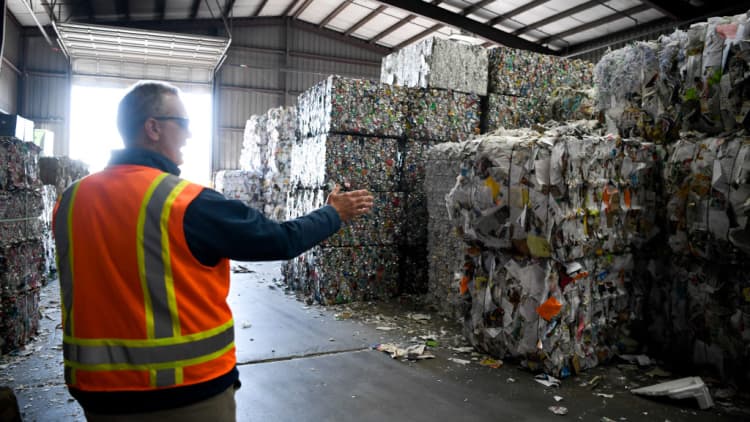Only 4.7% of plastic produced by U.S. households in 2021 was recycled, according to a Greenpeace USA report.
But that's not for lack of consumer participation. Greenpeace said most plastics simply cannot be recycled in the U.S., and since China has increased its standards for accepting recyclables, less plastic is getting reprocessed.
In honor of Earth Day, here's what you should know about the different types of plastics and which ones are likely to be reprocessed.
There are seven different types of plastics in consumer products, two of which are considered the most recyclable: PET, represented by the number 1 inside the recycling symbol, and HDPE, represented by the number 2.
Plastics labeled with a number 1 are about 20.9% likely to be reprocessed, according to the Greenpeace report.
These typically include soda bottles, peanut butter jars and other types of clear plastics. PET stands for polyethylene terephthalate.
Greenpeace found that plastics with the number 2 inside the symbol are half as likely as number 1 to be reprocessed, at 10.3%.
Examples of HDPE, which stands for high-density polyethylene, include laundry detergent bottles, shampoo bottles and other types of solid-colored plastics.
After that, plastics numbered 3 through 7 have a reprocessing rate of less than 5%, according to the Greenpeace report.
It is still important to know the difference between the types of plastics, since municipalities handle each type of plastic differently.
Plastics labeled number 3 are polyvinyl chloride, which is used to make items such as vinyl records and PVC pipes, according to the New York State Department of Environmental Conservation.
LDPE, or low-density polyethylene, is labeled with the number 4 and can be used to make bread bags, bubble wrap, cling wrap and more. This type of plastic film is often collected separately from plastics labeled 1 and 2. In New York City, for example, large grocery stores are required to have a collection bin for these types of plastics, which should not be collected in curbside recycling bins.
Plastics labeled number 5 are polypropylene, or PP, which can be used to make yogurt containers and other dairy product tubs, according to the conservation department.
Polystyrene, or PS, is labeled number 6 and can be used to make takeaway containers, coffee cups, insulation and disposable coolers. Styrofoam, which is the brand name of DuPont's polystyrene, is a commonly used term for this type of plastic foam.
Finally, plastics labeled number 7 are a mixture of various types of plastics.
Correction: This story has been updated to reflect that DuPont is the current owner of the Styrofoam brand. A previous version named an earlier owner of the trademark.




